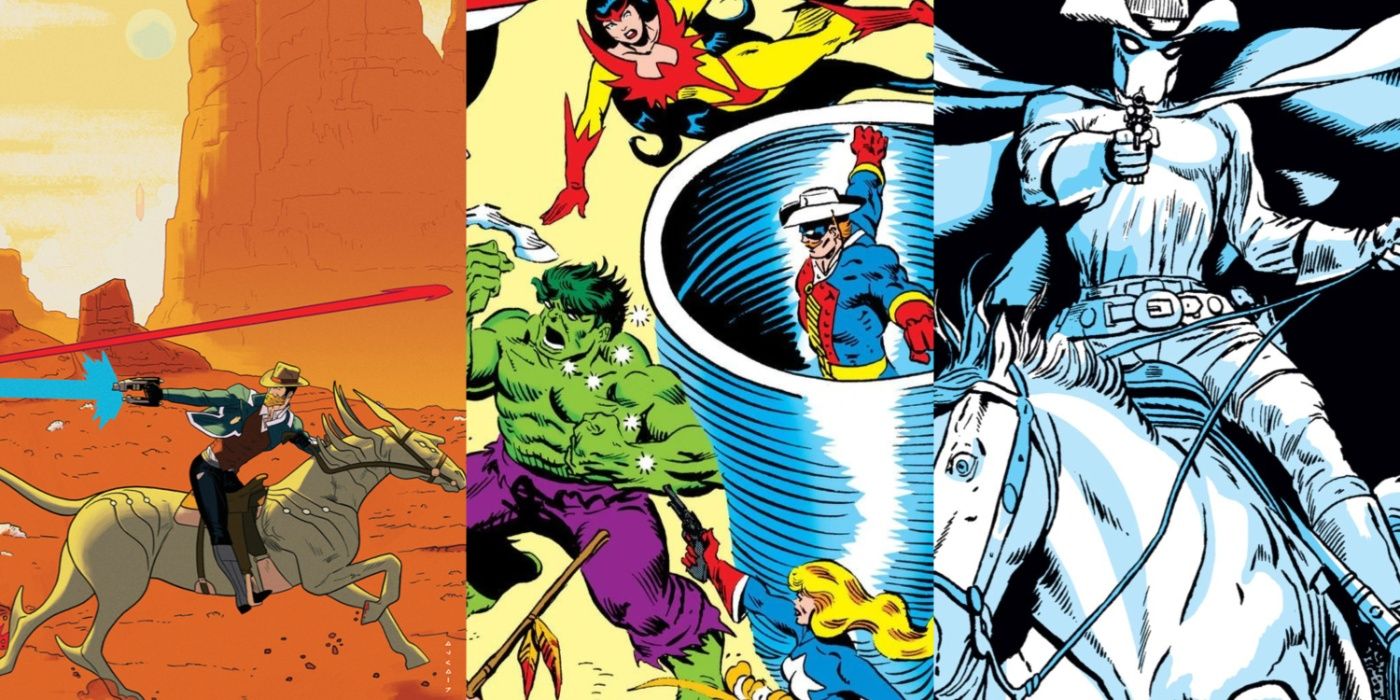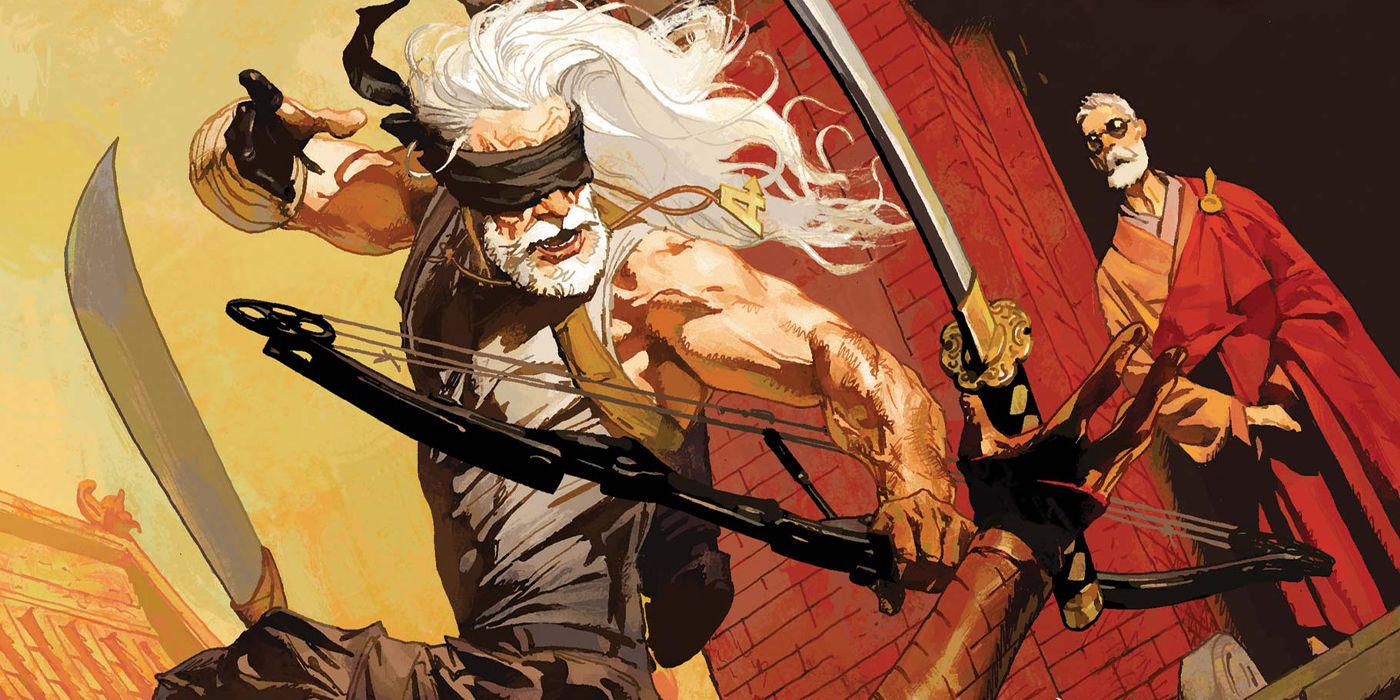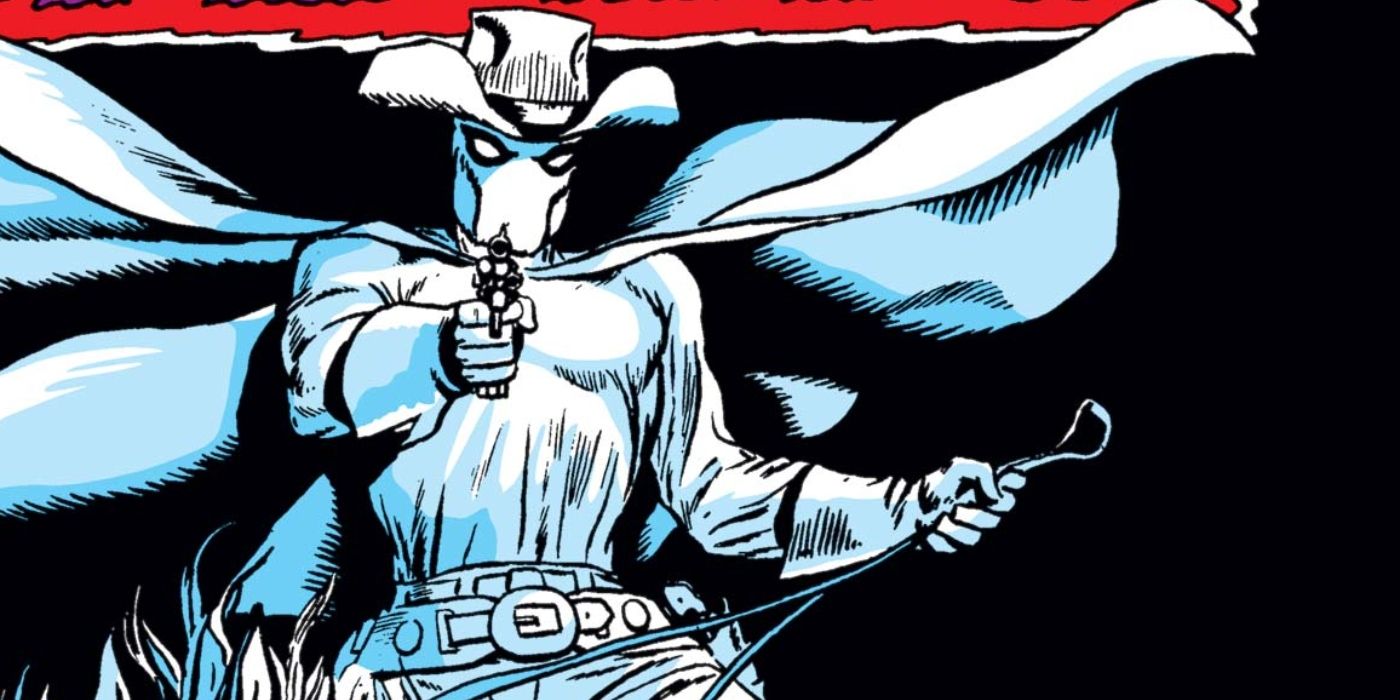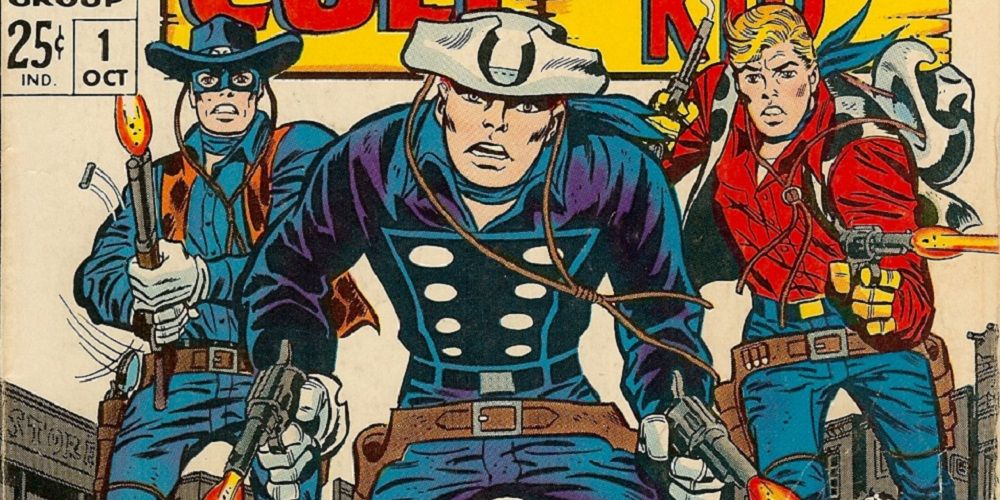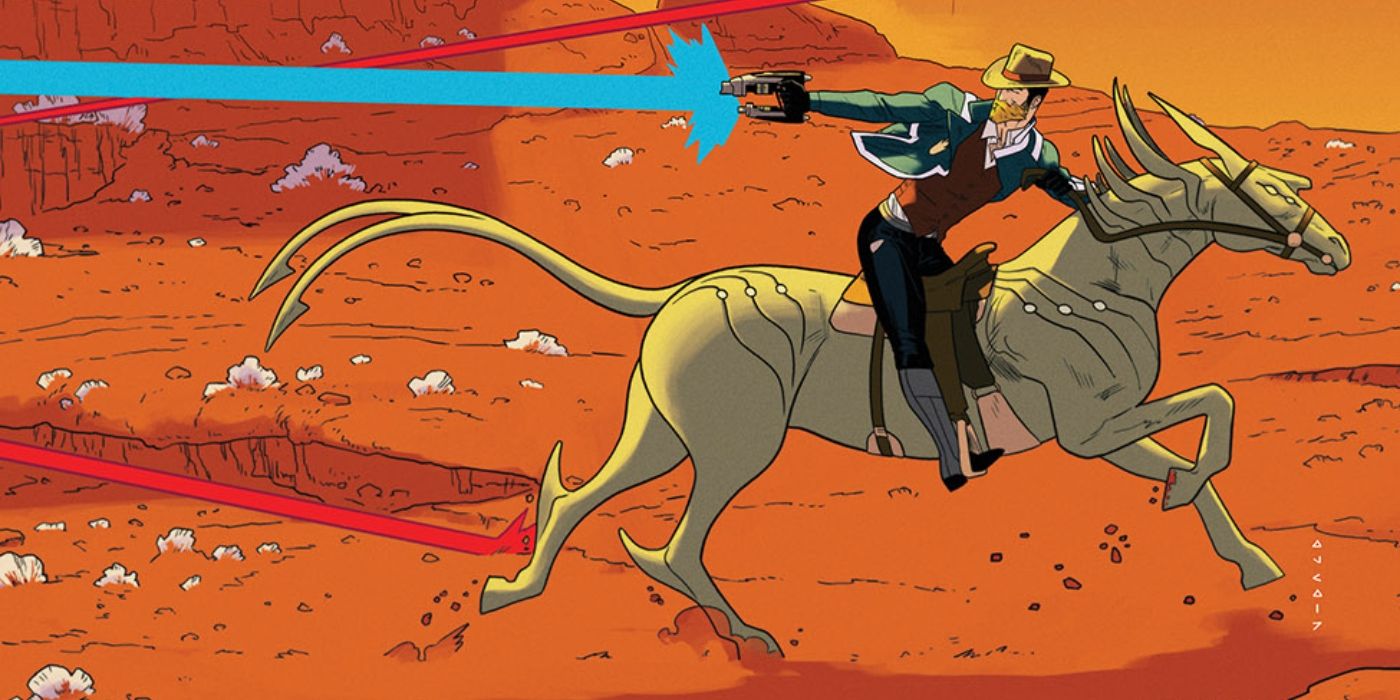The Western genre hasn’t been featured on the big screen quite as much as it was during Hollywood’s golden ages. There’s room for the genre to return, with shows like Westworld demonstrating how a unique twist can really connect with audiences. Marvel Studios are surely eyeing up the film category as they look to expand their own slate. They have a rich history of comics to draw inspiration from if they wish to do so.
During Marvel’s early years western comics made up a huge portion of their sales. Times changed and superheroes took over, but there have still been connections to the Wild West whether it’s via returning characters or thematic shifts. These comics could very well form the basis of a future Marvel Western adventure set within the Marvel Cinematic Universe.
10 Two-Gun Kid #60 (1962)
Writer: Stan Lee, Penciler: Jack Kirby, Inker: Dick Ayers, Editor: Stan Lee
The Two-Gun Kid run had already been popular among fans, but Marvel decided to change up proceedings and introduce a brand-new iteration of the character. ‘The Beginning of the Two-Gun Kid’ marked the debut of Matt Hawk, a heroic gun-slinger who sets up a law office in Tombstone, Texas.
The comic features all the hallmarks of a classic origin story and is firmly set within the Wild West. If Marvel is looking for a narrative to adapt that follows the conventions of the genre and utilizes an iconic Marvel vigilante, then Two-Gun Kid #60 is the best book to take inspiration from. It’s certainly paint-by-numbers, but it’s those familiar beats that help set the stage for Two-Gun Kid’s immense legacy.
9 Wastelanders: Hawkeye #1 (2021)
Writer: Ethan Sacks, Penciler: Ibraim Roberson, Inker: Ibraim Roberson, Colorist: Dija Lima, Letterer: Cory Petit, Editor: Mark Basso
There have been many alternative takes on the genre, from the neo-western to fantasy interpretations. Marvel Comics has also played on the category, utilizing a dystopic future timeline to tell the tales of famous heroes who fight through the grit and grime of a desolate world.
The Wastelanders series was inspired by the “Old Man Logan” narrative, with characters like Black Widow and Peter Quill getting this grounded spotlight. However, the Hawkeye narrative is a particular standout, with the former Avenger learning how to operate as an archer after losing his sight, by training under Matt Murdock. It’s a moving tale, with a Western backdrop, which could provide ample material for an apocalyptic Marvel Studios flick in the future.
8 Ghost Rider #1 (1966)
Writers: Dick Ayers, Gary Friedrich & Roy Thomas, Penciler: Dick Ayers, Inker: Vince Colletta, Letterer: John Verpoorten, Editor: Stan Lee
The interpretations of Ghost Rider have been endless. From Robbie Reyes and Danny Ketch, to Johnny Blaze and the Cosmic Ghost Rider, each iteration of the character brings something different to the table. But the narrative ‘Origin Of The Ghost Rider’ established the ghoulish Western version of the hellish hero.
Often referred to as the Phantom Rider in the years since, Carter Slade is the man behind the mask in a simple narrative that focuses on themes of revenge, religion, and justice. It’s easy to imagine this becoming a Disney+ special feature as a way of expanding the MCU’s Ghost Rider lore, while naturally setting a narrative in the Wild West of the past. It’s bold storytelling that mixes the supernatural excitingly with the genre.
7 Spider-Verse #4 (2020)
Writer: Taran Killam, Penciler: Juan Gedeon, Inker: Juan Gedeon, Colorist: Brian Reber, Letterer: Joe Sabino, Editors: Nick Lowe, Kathleen Wisneski & Martin Biro
The Spider-Verse is a huge and confusing place, full of various Spider-People with bizarre and unexpected gimmicks. Spider-Verse #4 was another comic to feature a unique cowboy, known as the Web-Slinger. The narrative sees Miles Morales travel to Earth-31913 where he teams up with the masked hero to rescue a village from some bandits.
The story has all the hallmarks of a great Western adventure and Marvel has been playing around with the Multiverse in recent years. Perhaps a Spider-Verse-esque film that sees the wall-crawler traveling across dimensions would provide an opportunity for a Western interlude. The superhero twist makes it a little more accessible for audiences who aren’t familiar with the genre.
6 Deadpool: Merc With A Mouth #7 (2010)
Writer: Victor Gischler, Pencilers: Bong Dazo, Kyle Baker, Rob Liefeld & Das Pastoras, Inkers: Jose Pimentel, Kyle Baker, Rob Liefeld & Das Pastoras, Colorists: Matt Milla, Kyle Baker, Rob Liefeld & Das Pastoras, Letterer: Jeff Eckleberry, Editor: Axel Alonso
The Multiverse has often been a way for Marvel to step back into the Wild West without worrying about time travel mechanics. Deadpool has met so many variants of himself and Deadpool: Merc With A Mouth #7 utilizes a few variations like Major Deadpool and The Deadpool Kid.
The Deadpool Kid is a Western-style character akin to the heroes of the heyday of comics and hails from a world that seemingly never moved away from the Wild West era. Characters like Sheriff Fury and bounty hunter Logan round out this rich universe, promising plenty of inspiration for a What If…? western flick that reimagined familiar faces. Of course, as is natural with Deadpool, it would likely be a very violent interpretation of the genre.
5 Mighty Marvel Western #1 (1968)
Writer: Stan Lee, Pencilers: Jack Kirby, Jack Keller & Dick Ayers, Inker: Dick Ayers& Jack Keller, Colorist: Stan Goldberg, Letterer: Artie Simek, Editor: Stan Lee
There are some comics from Marvel history that went all out with the Western genre and the Mighty Marvel Western run is a prime example. Featuring an expanding roster of Western heroes, many of which had previously featured in their own books, this collection of tales truly helped to form the basis of Marvel’s lore within the genre.
Characters like Two-Gun Kid, Rawhide Kid, and Kid Colt appeared in the first issue, with the groundwork being laid for a 46-issue run that truly demonstrated the scope and depth of Marvel’s Wild West. If Marvel Studios are looking to create a wider franchise with a sprawling cast of characters then #1 of Mighty Marvel Western is a natural starting point to build from.
4 Two-Gun Kid: Sunset Riders #1-2 (1995)
Writer: Fabian Nicieza, Penciler: Christian Gorney, Inker: Michael Halbleib, Colorists: Marie Javins & Michael Kraiger, Letterer: Richard Starkings Comicraft, Editor: Marcus McLaurin
Marvel had deemed the Western narratives as mostly a thing of the past throughout most of their modern release schedules, with superheroes still dominating their published books. However, Sunset Riders #1-2 was an attempt to modernize the genre slightly, bringing back Two-Gun Kid and surrounding him with new figures for a new generation.
This slightly more self-contained narrative is a perfect way to introduce audiences to the tone that Marvel is looking to create, with the Sunset Riders acting as an excellent team to base a franchise around. There’s an elevated level of grittiness to these books that contrasts against what Marvel previously did with the genre, with the politics and grounded themes of the run lending themselves to a more adult-orientated cinematic outing.
3 Wild West #1 (1948)
Penciler: Mike Sekowsky, Inker: Frank Giacoia, Editor: Stan Lee
“Arizona Annie” is the narrative of particular interest in Wild West #1. The comic marks the first appearance of the character. She’s particularly notable because Marvel didn’t utilize many major female Western heroes, but Arizona Annie could easily be adapted to the screen and connect on a deeper level with audiences.
The book acts as a classic origin story, setting up Annie’s skillset while allowing her to surpass the expectations of her peers by rounding up a gang of criminals. It’s a simple narrative, but one that can be stretched out and added to for a larger movie. One that focuses on the politics of the time period and how this incredible vigilante overcame the obstacles in her path.
2 Incredible Hulk #265 (1981)
Writers: Bill Mantlo & Sal Buscema, Penciler: Sal Buscema, Inker: Sal Buscema, Colorist: Bob Sharen, Letterers: Diana Albers & Jean Simek, Editor: Al Milgrom
Team-up Western narratives often work well in televised formats, but a superhero Western team on the big screen is certainly a concept worth exploring. The Incredible Hulk narrative “You Get What You Need!” first introduces audiences to The Rangers, a group originally consisting of Firebird, Nightrider, Shooting Star, Texas Twister, and Red Wolf.
The story features this group unexpectedly forming to take down a corrupted Hulk. It’s a tale that shows their strength as a unit and establishes the team moving forward. The Rangers would later appear in runs like Avengers: Initiative where their roster continued to change. But this comic forms the groundwork to create a similar team in the MCU, which can operate in the modern day but utilize many of the elements of the Wild West.
1 Star-Lord Annual #1 (2017)
Writer: Chip Zdarsky, Penciler: Djibril Morissette-Phan, Inker: Djibril Morissette-Phan, Colorist: Mat Lopes, Letterer: Cory Petit, Editors: Darren Shan, Kathleen Wisneski & Jordan D. White
Blending characters with unexpected genres is something that Marvel loves to do, and it was certainly an intriguing decision to place Peter Quill in the middle of a space western. Science fiction seems to work so well with the Western genre, and Star-Lord is the perfect gun-slinger to insert into that narrative.
The Star-Lord Annual #1 provides Quill with a Western-style backdrop, complete with a local Sheriff. With townsfolk getting robbed the story plays out with all the typical beats until a Mephisto twist upends everything. It’s a great comic to explore further and one that could frame Quill’s next big screen adventure, departing from the cosmic comedy he had previously been involved with.
